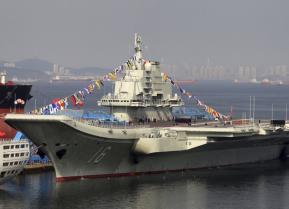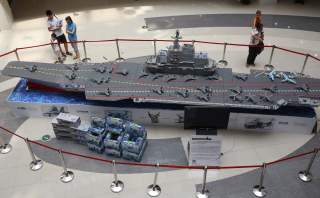Coming Soon: China's Navy Could Eventually Have Six Aircraft Carriers
And each new ship will likely get better and better. Read on.
China's first homemade aircraft carrier left her home port of Dalian for her third sea trial on Oct. 28, 2018. The Type 001A flattop could commission into frontline service as early as 2019, according to the U.S. Defense Department -- growing Beijing's carrier force to two and giving China the world's second-biggest flattop fleet.
The new trial will test the vessel's weapons system, control system and communications system, Wang Yunfei, a retired Chinese navy officer, told Global Times.
The 55,000-ton carrier, which Beijing reportedly will name Shandong, is a modified version of Liaoning, China's first flattop. Liaoning is the ex-Varyag, which the Soviet Union built in the 1980s but never commissioned.
China acquired the incomplete vessel in 1998. Liaoning commissioned into the Chinese fleet in 2012. Carrying J-15 fighters and helicopters, Liaoning deployed to the western Pacific in April 2018 for her first realistic war game.
Shandong, if that indeed is the new carrier's name, shares Liaoning's layout and limitations. Lacking catapults, she launches planes by way of a bow-mounted ramp. That arrangement places hard limits on how heavy Liaoning's aircraft can be -- and how much weaponry and fuel they can carry.
The U.S. Navy's own carriers use steam catapults to launch aircraft weighing as much as 50 tons. By contrast, Lianong's ramp layout probably limits aircraft to a maximum weight of 30 tons, a former Chinese navy source revealed. A J-15 weighs nearly 20 tons empty. Fuel accounts for most of the available 10-ton payload on most missions, limiting the fighter's weapons loadout to just a few small missiles.
But future carriers could be better as China's decades-long investment in naval aviation begins to pay off. "Observers speculate China may eventually field a force of four to six aircraft carriers, meaning Liaoning, the Type 001A carrier and two to four additional carriers," Ronald O'Rourke, a naval expert with the U.S. Congressional Research Service, reported in August 2018.
The United States is the biggest carrier operator, with 10 large flattops in service. France, the United Kingdom, India and Russia each possess one carrier. Several navies operate amphibious assault ships that can support fixed-wing aircraft.
A third Chinese carrier that's under construction in Shanghai reportedly features catapults. "China’s next generation of carriers will probably have greater endurance and be capable of launching more varied types of fixed-wing aircraft, including [electronic warfare], early-warning and [anti-submarine warfare] aircraft," the U.S. Defense Department explained in the 2018 edition of its annual report on Chinese military power.
With more and better flattops -- and new aircraft to fly from them -- China could greatly extend its influence across the Pacific and Indian Oceans. "By 2020, carrier-based aircraft will be able to support fleet operations in a limited air-defense role," Jesse Karotkin, the Office of Naval Intelligence’s top China analyst, said in 2014.
Recommended: Forget the F-35: The Tempest Could Be the Future
Recommended: Why No Commander Wants to Take On a Spike Missile
Recommended: What Will the Sixth-Generation Jet Fighter Look Like?
"These improvements would increase the striking power of a potential carrier battle group in safeguarding China’s interests in areas beyond its immediate periphery," the Pentagon explained in its 2018 China report.
David Axe edits War Is Boring . He is the author of the new graphic novels MACHETE SQUAD and THE STAN.
Image: Reuters.


